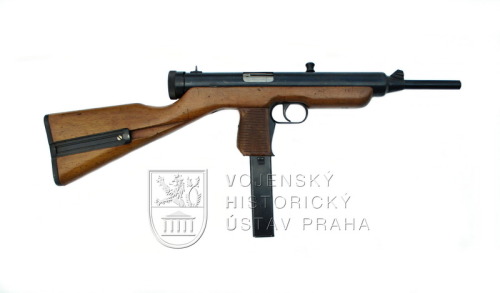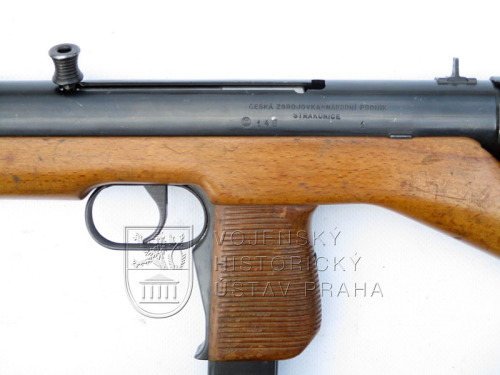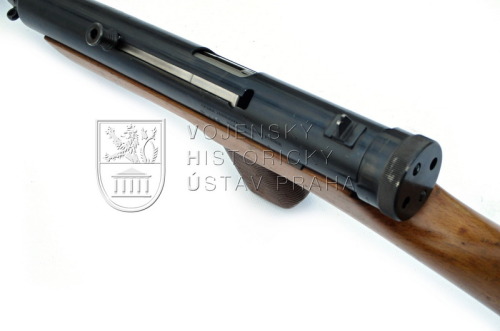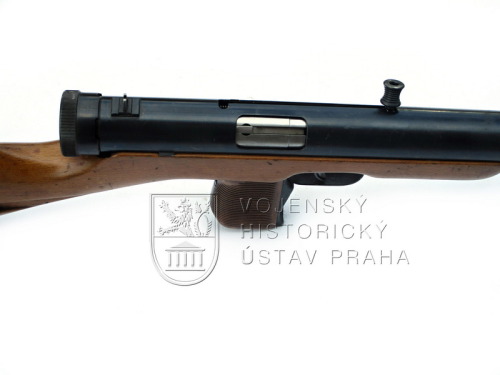Samopal ČZ 148The prototypes marked ČZ 148 and ČZ 447 from the Czech Armoury in Strakonice brought a
Samopal ČZ 148The prototypes marked ČZ 148 and ČZ 447 from the Czech Armoury in Strakonice brought a fundamental change in the view of the conceptual arrangement of the submachine gun in post-war Czechoslovakia. The Brno armoury built the ZK 476 prototype to compete against them, the basic concept of which was based on the same idea: shortening the length of the weapon by moving the breech mass above the barrel and placing the magazine in the pistol grip, as in the case of self-loading pistols.The project of the then lance corporal Jaroslav Holeček (1923-1997), who was transferred from the Military Technical Institute (VTU) to the design office of the Czech Armaments Factory in Strakonice, was the initiator of the new concept.According to his design, a prototype with the designation H/p was created, which at first glance resembled a rather enlarged self-loading pistol. Its breech, similar to that of a pistol, ran largely over the barrel, housed in a breech housing, and the magazine was housed in a pistol grip with an open front wall. The basic arrangement was applied for patent protection by the Czech Armaments Factory together with Jaroslav Holeček on 25 September 1947 and was granted Czechoslovak Patent No. 79 574 with the general title of Self-loading firearm.Under the direction of chief designer František Myška (1899-1983), the designers Jaroslav Holeček and Jiří Čermák (1926-2006) developed a submachine gun in an infantry version, originally designated ČZ 47 (later renamed ČZ 148), and a paratrooper version with the original designation ČZ/47, renamed ČZ 447. Unlike Holecek’s initial H/p design, the submachine gun had a cylindrical breech housing with a closed front wall of the grip.The swinging tension handle also acted as an anti-recoil safety, which prevented the bolt from moving inertia when the weapon was shaken or impacted. The design of the bolt was based on the model, so that its centre of gravity was above the barrel, which contributed to better stability of the weapon during firing. The ejection window remained covered by the bolt wall when the bolt was cocked and released, eliminating the possibility of dirt entering the machine gun mechanism.In the autumn of 1947, the MNO sent prototypes of the ČZ 47/II and ZB 47 submachine guns for departmental trials, but both factories, Česká zbrojovka and Zbrojovka Brno, submitted the 148 to the VTÚ in February, i.e. at the time of the ongoing trials of the new design: the Strakonice factory came up with both variants of the ČZ 148 and ČZ 447, the Brno armoury with Josef Koucký’s prototype marked ZK 476. At a meeting of the VTU held on 10 February 1948, it was decided to include the submitted prototypes in the ongoing competition due to their design merits, but with the proviso that the new weapons would be tested only during March 1948. Thus, the MNO ordered 14 ČZ 148 submachine guns and 6 ČZ 447 paratroopers from Česká zbrojovka and 20 ZK 476 submachine guns in infantry and paratrooper versions from Zbrojovka Brno in the same proportion.The submachine guns were to be allocated to those units which were already testing prototypes, but also to airborne units. In order to gain a broader knowledge of the paratroop prototypes, it was decided to allocate one of each to the infantry school in Milovice, with the requirement to check whether the paratroop versions would meet the needs of infantry units. Tests with them were to be completed by the same date as with the ZB 47 and ČZ 47/II prototypes, i.e. by the end of March 1948. This brought the future favourites into the army machine gun game.In March 1948, i.e. during the ongoing trials, the Czech Armaments Factory submitted a new, quite radical solution to the VTU, which achieved the required versatility of the weapon. In the prototype submitted, designated ČZ 447 univ., the folding shoulder rest could easily be exchanged for a fixed stock and vice versa. The author of this solution was František Brejcha, the then director of the Czech Armaments Factory branch plant in Uherský Brod. At that time, no submachine gun in the world had the possibility to easily exchange the stock for a folding shoulder rest. At the same time, VTÚ called on Zbrojovka Brno to address the versatility of the ZK 476 submachine gun in this concept.One of the drawbacks of the Strakonice submachine guns that made it into the departmental tests was the non-removability of the barrel, pressed into the front sleeve of the breech housing. The main problem was that the inner part of the breech housing was difficult to clean precisely because the barrel could not be removed. The Czech Ordnance Factory did not start to look into the design of the exchangeable barrel until mid-June 1948, when the VTU presented three alternatives for a possible solution. At that time, the requirement of an interchangeable barrel for practice firing was already on the table, which not only supported the design work, but also accelerated it due to the hectic nature of the ongoing tests.With the requirement for the versatility of the weapon in terms of a possible change from infantry to paratrooper design, attention was focused mainly on the prototypes of the ČZ 447, so that the infantry version of the ČZ 148 was no longer pursued by the MNO and its history was thus closed before the final decision between the Strakonice and Brno submachine gun designs. In total, the Czech Armoury produced 18 ČZ 148 submachine guns during 1948.The museum acquired a specimen of the ČZ 148 submachine gun with the number 1 in 1995 by transfer from Prototypy, a. s., Brno.Calibre: 9 mm ParabellumOverall length: 660 mmBarrel length: 300 mmIntentional length: 321 mmMagazine capacity: 20/40 rounds (the specimen has a 40-round magazine)Weight of the weapon without magazine: 2840 g Jan Skramoušský -- source link
Tumblr Blog : weaponvault.tumblr.com
#firearm#prototype#submachine gun#czechoslovakia





